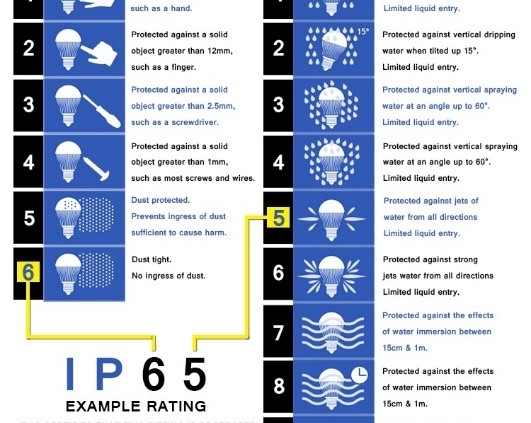
The IP rating system is an Internetional IEC standard that applies to many product categories including lighting.
Why IP Ratings Are Important?
The IP rating informs the buyer how well protected the light fixture is against particulates and water getting inside the fixture to cause damage.
Fixtures intended for outdoor installation and shower rooms are two obvious examples of applications where it is important to know how well sealed the fixture is against moisture and water penetration.
Other examples include fixtures located in food processing plants where they will likely be exposed to direct contact, high pressure water during hose-down at the end of a shift.
Also, any lighting used on boats or yachts has the potential to encounter either splashing water or are specifically designed to be used fully submersed under water. Navigation lights, for instance, used on the exterior of the boat but not fully submersed, typically feature slightly less water protection than decorative udnerwater lights.
Similarly, fixtures located in warehouses and industrial applications can be subjected to very dusty, high particulate environments that, if not well protected, could cause poor illumination performance or even damage to the fixture.
Each of these examples will require fixtures with a different level of particulate and water protection. The IP rating provides the necessary information.
Decoding the IP Rating
The IP metric is a two digit numerical value.
The first digit denotes the level of protection against solids – particulates, dust and other solid objects in the environment. Higher numbers mean the fixture enclosure gasketing is designed to prevent the entry of smaller and smaller particulates.
The second digit refers to the level of protection against liquids. Low numbers mean limited protection, higher numbers mean greater protection with the highest number, 8, meaning the fixture is sealed well enough to be completely submerged in water without damage.
IP Rating: First Digit (Protection against solids)
- 0 – No protection against entrance by an object
- 1 – >50 mm in size; fixture protected against entry
- 2 – >12.5 mm in size; fixture protected against entry
- 3 – > 2.5 mm in size; fixture protected against entry
- 4 – >1 mm in size; fixture protected against entry
- 5 – Dust protected; dust has to enter in large amounts to interfere with operation
- 6 – Dust tight; impossible for dust to enter
IP Rating: Second Digit (Protection against liquids)
- 0 – No fixture protection against entry by water
- 1 – Dripping water; no damaging effect on fixture against vertical dripping water
- 2 – Dripping water tilted up to 15°; no damaging effect on fixture against vertical dripping water
- 3 – Spraying water; no damaging effect on fixture at any angle up to 60°
- 4 – Splashing water; no damaging effect on fixture at any angle
- 5 – 6 Waterproof
- 7 – Immersion up to 1 m; water will not enter the fixture
- 8 – Immersion beyond 1 m; fixture is suitable for continuous immersion in water
Examples
Light with IP44. This fixture has moderate protection against particulates and is protected against splashing water.
Wall Pack with IP65. This fixture has 100% protection against entry of dust or particulates and it is protected against damage from water. This high level of protection against both dust and water means this fixture can be safely installed where it is fully exposed to environmental dust and all rain conditions.
Many marine lights are either IP67 or IP68, depending on the type of boat they are designed to be used with. Underwater lights, for instance, are usually IP68, meaning they are able to be used fully submersed.
Before choosing your lighting consider the value of IP!


